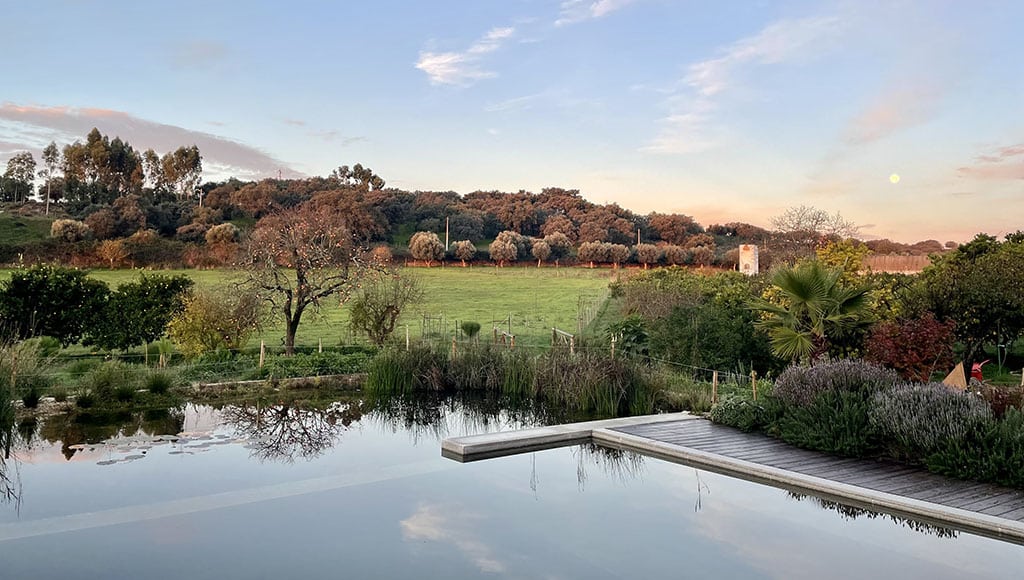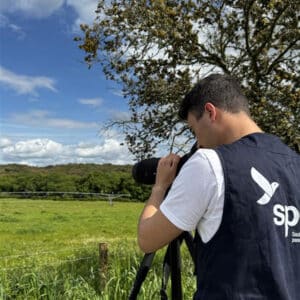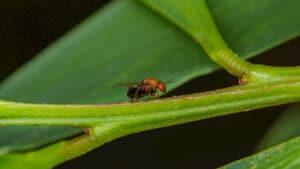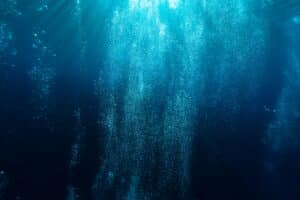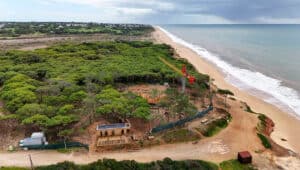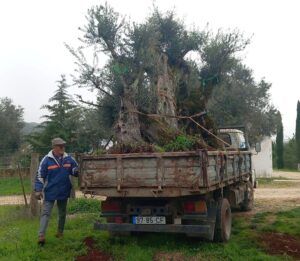Seven years ago, my husband João and I fell in love with a farm in interior Alentejo that was in a state of (almost) total disrepair. We love a good project, and we had a dream of leaving our corner of the world better than we found it. This has become our ethos and the filter through which we make all our farm decisions.
So, when it came time to build a swimming pool, we wanted it to be part of the natural landscape while avoiding the harsh chemicals of most conventional pools. A bio pool, also called a natural pool, differs dramatically from a traditional pool in its approach to water purification. Instead of relying on chlorine and other chemicals, it mimics natural bodies of water by using plants and beneficial bacteria to clean and filter the water.
In theory, the idea of a natural pool made perfect sense and aligned with our commitment to improving our land.
But the truth is, I wasn’t fully convinced.
We went ahead anyway with a plan for a pool that is divided into two zones: a swimming area and a regeneration zone, where aquatic plants purify the water. The initial construction involved excavating the zones and creating different levels for various types of plants – shallow areas for grasses and deeper areas for floating plants. Our swimming zone is a traditional, rectangular-shaped pool that is surrounded on three sides by a “pond”. The water moves between the two areas, constantly being filtered and cleaned.
The first two years were challenging, and I doubted many times whether we had made a huge mistake. Unlike a conventional pool that’s ready for swimming almost immediately, a bio pool needs time to establish its ecosystem. We had no idea, when we started, that it would take much longer than we expected.
In the beginning, our water clarity was inconsistent. On some days, it was crystal clear, while on others, algae appeared. This happens because the plants require time to become established, and the natural filtration system needs to stabilize.

Biofilm is another aspect of natural pools. Unlike pristine, chemically treated pools, bio pool liners always have a thin, slippery layer of film. While it’s a natural and important part of the ecosystem, it feels slippery underfoot, and takes some getting used to. We use a special vacuum to clean the bottom of the pool, and, in the hottest season, we use a pump that runs on solar power.
Things started to change in the third year. The plants had matured, creating a more stable ecosystem. Beautiful water lilies spread across the regeneration zone. Their leaves provide shade that prevents algae growth; regulate water temperature during the intense summer heat; and help conserve water by reducing evaporation. They also provide a perfect landing place for the native frogs and dragonflies that signal a healthy environment. Frogs?
At this point, we were falling in love with the pool. Not everyone felt the same. Our friends fall into two camps. There are those that claim to love the idea of a natural pool – but the reality of swimming with frogs is too much.
We’ve learned to set the expectations of first-time visitors by calling it a “swimming pond”. Yes, there might be a frog. No, they probably won’t get close. And then there are other friends who prefer chlorine and refuse to believe that swimming can be safe without chemicals.
Swimming in a natural pool is a very different experience from a conventional pool. The water feels softer on the skin, and there’s no chlorine smell or eye irritation.
During the long, dry Alentejo summers, when rainfall is nonexistent, natural water sources are scarce.
In these parched months, our pool becomes an oasis – for us, and for birds, butterflies and a whole community of insects and amphibians who find precious water. At night, we sit under the starry sky listening to frog song, while bats and swallows swoop in and out.
Today, our pool is wilder and more beautiful than I could have ever imagined. The edges have weathered, and tall grasses have established themselves naturally, making the pool look as if it has always been part of the landscape.
The deep understanding of ecosystems and our place within them has been my most profound lesson. Unlike a conventional pool where humans and chemicals control the environment, the pool has taught us how to be in dialogue with nature. We’ve learned to observe, respond, and adapt. Each element plays its part, including us.
We are all participants.
It’s changed how we view our broader relationship with the natural world. It’s one thing to intellectually understand what it means to be part of an ecosystem, but it’s another to swim in one every day, to watch it through the seasons, through natural cycles of growth and rest.
The pool is a daily reminder that the most resilient systems are those where every participant – from the smallest beneficial bacteria to the humans – finds their place.

